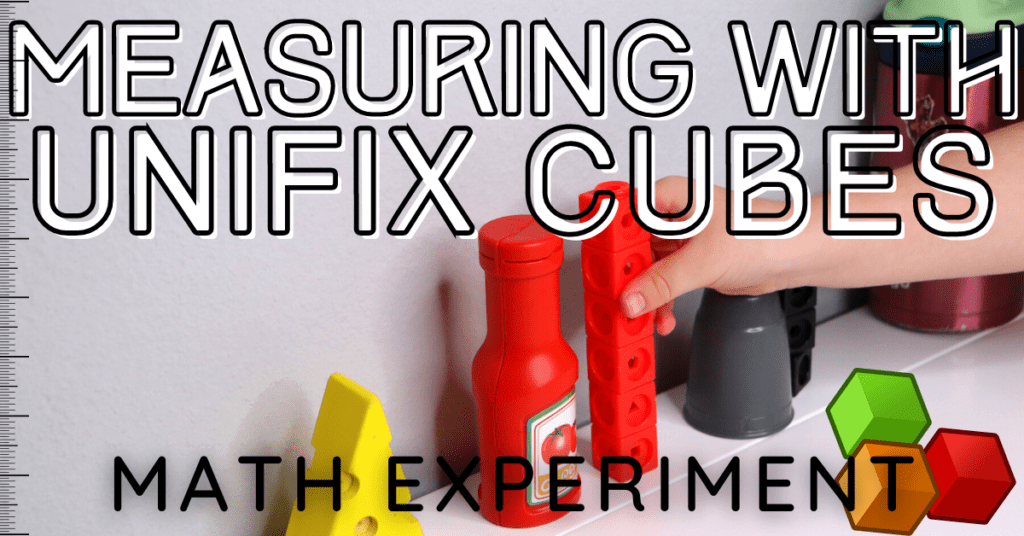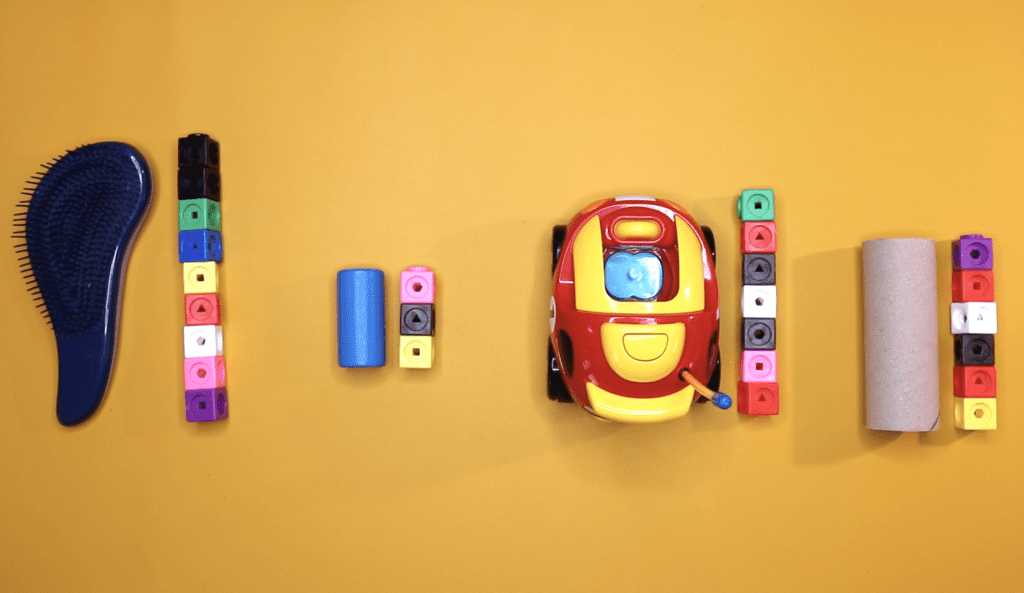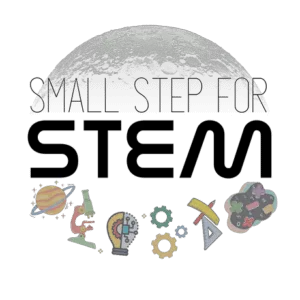Disclosure: this post contains affiliate links, which means I may receive a commission if you click a link and purchase something at no extra cost to you. Please check out our policies page for more details.
for more details.
Measuring objects is one of the first things we learn about mathematics and can be learned at a very young age. This concept can be as simple as noticing that one object is bigger (and better!) than another or that your sibling has more macaroni than you.
Using Unifix cubes to assign a height to a household object teaches your child how to measure things, one-to-one correspondence, and how to compare the heights of objects. It’s a great foundation to learning how to measure objects with different units.
All you need is some Unifix cubes and access to a few household items and you’re ready to go!

How to make the Measuring with Unifix Cubes math experiment
Supplies you will need
For this experiment, you will need the following:
Before you start
This is an introduction to measuring the height of objects for your child. At this stage, we are simply showing that objects can be measured in some sort of unit (the cubes, in our case). Once that is understood, it will be easier to move on to different units of measurement.
Also, since Unifix cubes are a choking hazard for young children, keep track of where the cubes are and that no one puts them in their mouth!
Instructions
Here is how to do the Measuring with Unifix Cubes experiment with your toddler:
Step 1: Gather objects from around the house to measure

This is a great activity to let your child take control. You will want to step in it looks like they are choosing many things that are the same height since we want to show that different objects can have different heights.
Here are some ideas on what to measure, if your child does not want to choose:
- Toothbrush
- Favorite stuffed animal
- Their drinking cup
- A pencil
- Favorite book
- Loaf of bread
- Toy car
Get your preschooler involved: If your child wants to choose the items to measure, let them choose about 5 to 10 household items. It doesn’t just have to be their toys; implore them to get creative!
Step 2: Line items up on the floor
We will be measuring all of the items while they are beside one another.
Why?
Once we are done measuring, it allows you to show the differences in height across all of our objects. It’s a great opportunity to compare the heights of objects out loud with your child.
Get your preschooler involved: Ask your child to make a line of all of our objects on the floor. If you (or they!) would like, you could add a line of tape on the floor to help line them up.
Step 3: Measure each item with the Unifix cubes

Beginning with the first object, have your child begin the measurement process.
This is an excellent time to ask the question: How many cubes do you think we will need for [object 1]? They may not have an answer, but you could always talk them through it and have a conversation on guessing the height.
Have your child begin to connect the cubes and measure them alongside the object. For the first few objects, you may need to hold the cube stack against the object to ask your child if they look like they’re the same height. If not, it’s time to add or take away some cubes!
Then, when you have talked about heights, you can ask your child which object is the tallest and shortest.

The math behind the Measuring with Unifix Cubes math experiment
This experiment teaches:
- The beginning stages of measurement
- Counting
- The varying height of objects (comparing heights)
How it works
Measuring with Unifix cubes is an excellent beginning to learning how we measure objects. Jumping into actual units of measurement (inches, feet, meters, etc.) can be overwhelming for a young kid.
Using Unifix cubes as your universal unit of measurement allows a solid foundation in measuring objects before introducing other units of measurement.
The beginning stages of measurement
Children begin the process of learning measurement far before we think to teach it to them.
Children arrive at preschool with an everyday understanding of measurement that starts in infancy and develops throughout early childhood, often without adult assistance.
Linda M. Platas, San Francisco State University
The goal of this experiment is to organize our child’s knowledge of measurement to begin consciously applying units to things we measure.
For example: instead of knowing that object 1 is taller than object 2, we can use this experiment to show how much taller object 1 is, while also applying units to the measurement.
Counting
This experiment covers even more than just measurement: there’s also a hidden lesson in one-to-one correspondence (where each object can only be counted once).
If your child struggles with counting individual objects and instead recites 1-10 when you ask how many there are of something, this would be a great lesson to introduce to them.
Since this experiment is all about counting the Unifix cubes associated with each household object, it’s a great way to drive home the fact that each cube is only counted once, and there are different numbers of cubes for each object.
Comparing heights
This is also a great opportunity to incorporate differing heights, like “taller than”, “shorter than”, and “the same height as”.
More math experiments with Unifix cubes to try out with your child
FAQ about the Measuring with Unifix Cubes math experiment
What is the measurement of a Unifix cube?
Each Unifix cube is measured to be 0.75 inches or 2 centimeters.
How do you use Unifix cubes in math?
Unifix cubes are so diverse! They can be used for:
- Adding and subtracting
- Measuring objects
- Sorting by color
- Building patterns
- Counting
The possibilities with these cubes are really endless, with a bit of creativity.
Recent Posts
Have you always wondered how a rocket launches into space? There's a lot that goes into it, but today's experiment helps kids to visualize rocket launches. This experiment demonstrates a rocket...
If you take the time to look, you'll find a surprising amount of symmetry when you step outside. Symmetry in nature is all around us! This experiment takes kids on an excursion to find symmetry in...
